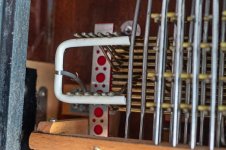That is right, and these are actually two separate issues.
The button returning is a consequence the three notes of the chord "pushing it back". But in reality only one note is needed to push the button back. It doesn't matter whether one two or all three pallets close. One of the three catorcetti is enough to push the button back up.
The second issue is that the bass mechanism (in a non-convertor accordion) contains separate springs to help push back the catorcetti.
I didn't have a picture ready but I found this video. On the left side of the video you see a U-shape bracket with two strips of felt. This is pushed back by a spring mechanism and it pushes all 12 catorcetti back. Alternatively the bass mechanism on other accordions has a fixed bracket and twelve small springs pulling the catorcetto towards the bracket. So you see: the catorcetti are pulled/pushed back by a mechanism that is independent of what the pallets are doing.
You also see a microphone installation. Here is the deal in my opinion: the only instrument of mine where I've seen that U-shape bracket is an Excelsior with factory MIDI installation. The purpose of the U-shape bracket is to make sure that if
a) bass buttons are being pressed
b) chord pallets get opened along with the bass pallets because of the bass/chord note coupling mechanism
c) no chord buttons are being pressed
then the chord catorcetti(?) are being held back together in the "unpressed" state by a single spring to keep chord MIDI notes from sounding randomly by catorcetti moving of their own accord when constrained neither by a pressed chord button nor by the spring of a closed chord pallet.
Since all the chord catorcetti are held back by a single spring, there isn't much additional resistance to overcome. The problem is that if you press, say, C bass together with Em chord, then the C chord catorcetto again is unconstrained and may move at its discretion, adding a C chord note to the MIDI at a random point of time.
So because this is the only context where I've seen this construct in my own instruments, I think it may be a crutch for MIDIfication of standard bass accordions that couple bass reeds into chord reeds (almost all of them do).
A corollary will be: if pressing down C, E, G bass buttons, will the C Major chord button fall in? With this construct the answer is no, without it the answer is yes. But I don't think this is the motivation because, well, who cares as long as no MIDI comes into play?

